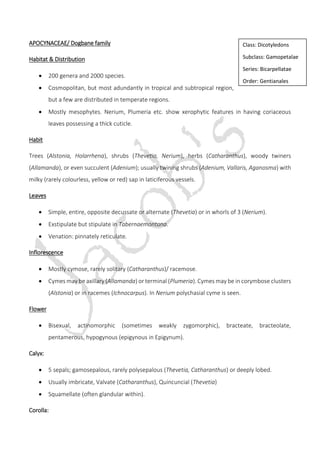
APOCYNACEAE.pdf
- 1. APOCYNACEAE/ Dogbane family Habitat & Distribution • 200 genera and 2000 species. • Cosmopolitan, but most adundantly in tropical and subtropical region, but a few are distributed in temperate regions. • Mostly mesophytes. Nerium, Plumeria etc. show xerophytic features in having coriaceous leaves possessing a thick cuticle. Habit Trees (Alstonia, Holarrhena), shrubs (Thevetia, Nerium), herbs (Catharanthus), woody twiners (Allamanda), or even succulent (Adenium); usually twining shrubs (Adenium, Vallaris, Aganosma) with milky (rarely colourless, yellow or red) sap in laticiferous vessels. Leaves • Simple, entire, opposite decussate or alternate (Thevetia) or in whorls of 3 (Nerium). • Exstipulate but stipulate in Tabernaemontana. • Venation: pinnately reticulate. Inflorescence • Mostly cymose, rarely solitary (Catharanthus)/ racemose. • Cymes may be axillary (Allamanda) or terminal (Plumeria). Cymes may be in corymbose clusters (Alstonia) or in racemes (Ichnocarpus). In Nerium polychasial cyme is seen. Flower • Bisexual, actinomorphic (sometimes weakly zygomorphic), bracteate, bracteolate, pentamerous, hypogynous (epigynous in Epigynum). Calyx: • 5 sepals; gamosepalous, rarely polysepalous (Thevetia, Catharanthus) or deeply lobed. • Usually imbricate, Valvate (Catharanthus), Quincuncial (Thevetia) • Squamellate (often glandular within). Corolla: Class: Dicotyledons Subclass: Gamopetalae Series: Bicarpellatae Order: Gentianales
- 2. • 5 petals (rarely 4), gamosepalous, united into a tube, usually salver-shaped or funnel-shaped (Nerium) or bell-shaped (Aganosma). • Mostly twisted, rarely valvate. • On the inner side of the throat of the corolla tube, hairy outgrowths or other appendages may be present and it is something like the corona of Asclepiadaceae. Androecium: • Stamens as many as corolla lobes, inserted at their throat and alternate with them. • Epipetalous, Free. • Anthers dithecous, introse, often sagittate, free or adherent by viscid exudates to the stigma or clavuncle, dehiscing longitudinally, an apical connective often produced, the pollen granular or rarely in tetrads (Condylocarpus). • Anther lobes may contain pollen grains fully or the lower part may be empty and prolonged into spurs (Nerium). Gynoecium: • Usually bicarpellary. The ovaries are two in number, distinctly separate but with a common style and stigma. • Each ovary is unilocular with numerous ovules along the ventral margin. • In some cases, the two carpels are completely fused, and the gynoecium is represented by a syncarpous ovary which is unilocular with parietal placentation (Chilocarpus) or bilocular with axile pacentation (Carissa). • Ovules are few to many in each carpel. Ovules may be anatropous or campylotropous. • The style is simple, but the stigma is often enlarged into a head or disc. • A nectarivorous disc is often present around or at the base of the gynoecium in several genera (Thevetia, Catharanthus, Allamanda, Rauvolfia). Fruit • Follicle/capsule/ berry/ drupaceous. • Seeds naked, comose (usually with a comma of hairs at one or both ends; coma absent from berries and drupes), or with a paper wing, occasionally arillate, endosperm straight, fleshy to firm-fleshy.
- 3. Pollination Entomophilous. Insects are attracted mainly because of often large and conspicuous petals and the presence of nectar. Because the receptive stigmatic surface is located on the underside of the stigma, cross-pollination is the rule of the family. Self-pollination is absent. Systematics and Phylogeny (Affinities) The family is closely allied to Asclepiadaceae and both are included in the same order almost in all systems of classification. However, Apocynaceae lack the pollinia, corona and translator-corpusculum of Asclepiadaceae. Economic Importance Ornamental Allamanda cathartica, Aganosma dichotoma, Beaumontia jerdoniana, Beaumontia grandiflora, Tabernaemonatana divaricate, Vallaris solanacea, Carissa carandus. Thevetia peruviana & Nerium indicum as hedge plants. Carissa spinarum for fragrant flowers and & hedge plants. Medicinal value Rauvolfia serpentina yields reserpine which can lower blood pressure and tranquilize mental patients suffering from schizophrenia. Thevetia peruviana: seeds used in rheumatism. Vallaris solanacea: Latex used in toothache and inflated gums. Holarrhena antidysentrica: root & bark in dysentery. Alstonia scholaris: bark used in malaria & dysentery. Cerbera manghas: Latex used as an emetic and purgative. Wrightia tomentosa: bark and roots used as antidote to snakebite. Strophanthus hispidus: yield the drug strophanthin. Rubber From the latex of Carpodinus, Funtumia, Hancornia, Landolphia & Rhynchodia. Poisonous Poisoned arrows are made from the bark extract of Acokanthera abyssinica and seeds of several species of Strophanthus. Edible Carissa carandas: fruits used as vegetable and is pickled. Carissa grandiflora yields edible fruits. Carissa spinarum: edible fruit. Wrightia tinctoria: edible fruits
- 4. Dye Indigo like dye obtained from the seeds of Wrightia tinctoria. Ropes, baskets and fishing traps Stems of Ichnocarpus frutescens. Wood Wrightia tomentosa: soft wood for carvings. Alstonia scholaris: wood is light and used for carvings. In Burma, blackboards are prepared from its wood.